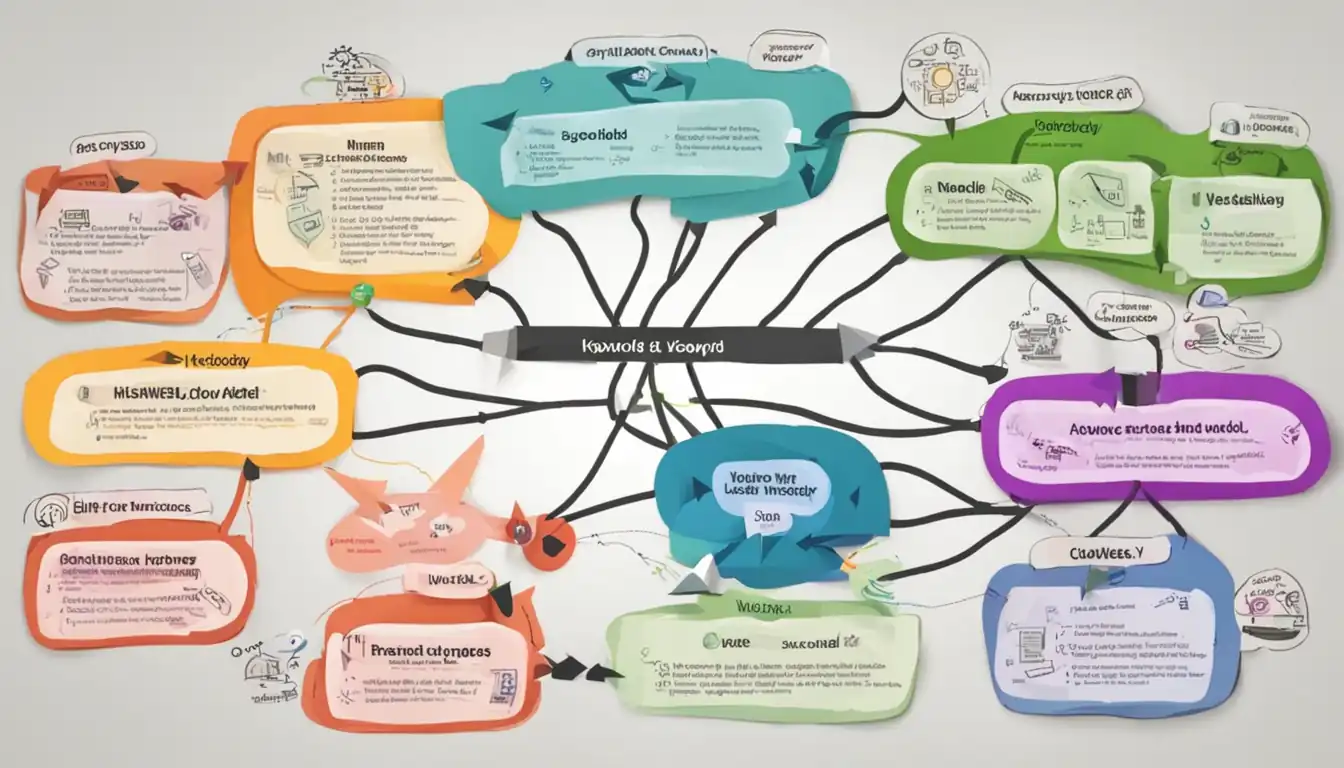Mastering Keyword Targeting: A Strategic Approach to SEO

Mastering keyword targeting is a crucial aspect of any successful SEO strategy. By understanding the role of keywords, crafting a strategic keyword strategy, and leveraging the right tools and techniques, you can improve your website's visibility and attract the right audience. In this post, we'll delve into the art of keyword targeting, from the basics to advanced techniques, and provide real-world examples and common mistakes to avoid.
The Essence of Keyword Targeting in SEO
Keywords are the foundation of any successful SEO strategy. They are the words and phrases that people type into search engines when looking for information, products, or services. Understanding the role of keywords in SEO is crucial for driving organic traffic to your website and improving your search engine rankings.
Understanding the Role of Keywords
Keywords act as a bridge between what people are searching for and the content on your website. By strategically targeting relevant keywords, you can ensure that your website appears in search results when potential customers are looking for information related to your business. This not only increases the visibility of your website but also attracts qualified traffic that is more likely to convert into leads or sales.
The Evolution of Keyword Relevance
In the early days of SEO, keyword targeting was a simple process of identifying the most popular keywords in your industry and using them throughout your website. However, search engines have become more sophisticated, and keyword relevance has evolved to focus on user intent and context. This means that simply stuffing your content with keywords is no longer effective. Instead, you need to understand the intent behind the keywords and create high-quality, relevant content that satisfies the user's search query.
By understanding the essence of keyword targeting in SEO and adapting to the evolution of keyword relevance, you can create a more effective and sustainable SEO strategy for your website.
Crafting Your Keyword Strategy

When it comes to optimizing your website for search engines, one of the most important steps is crafting a solid keyword strategy. This involves identifying your core keywords and balancing broad and long-tail keywords.
Identifying Your Core Keywords
The first step in crafting your keyword strategy is identifying your core keywords. These are the main keywords that are most relevant to your business and are highly searched by your target audience. To identify these keywords, you can use tools like Google Keyword Planner, SEMrush, or Ahrefs. Look for keywords that have a high search volume and are closely related to your products or services.
Once you have identified your core keywords, you can then build your content around them. These keywords should be naturally integrated into your website's content, including your homepage, product pages, and blog posts. This will help search engines understand what your website is about and improve your chances of ranking for those keywords.
Balancing Broad and Long-Tail Keywords
In addition to identifying your core keywords, it's important to balance broad and long-tail keywords in your strategy. Broad keywords are short and generic, such as "shoes" or "digital marketing," while long-tail keywords are longer and more specific, such as "women's running shoes" or "digital marketing agency in New York."
Balancing these two types of keywords is important because broad keywords have a higher search volume but also higher competition, while long-tail keywords have lower search volume but are more targeted and have less competition. By including both types of keywords in your strategy, you can attract a wider audience while also targeting specific, high-converting search queries.
Crafting a keyword strategy is a crucial part of content-driven SEO, and by identifying your core keywords and balancing broad and long-tail keywords, you can improve your website's visibility and attract more organic traffic.
Tools of the Trade: Keyword Research Tools
When it comes to optimizing your website for search engines, keyword research is a crucial step. It helps you understand what your target audience is searching for and allows you to tailor your content to meet their needs. In this section, we will explore some popular keyword research tools and how to analyze keyword metrics for better selection.
Popular Keyword Research Tools and Their Features
Before diving into keyword research, it's important to have the right tools at your disposal. There are several popular keyword research tools available, each with its own unique features and capabilities. Here are a few of the most widely used tools:
Google Keyword Planner: This tool is a favorite among many SEO professionals due to its comprehensive data and integration with Google Ads. It provides insights into search volume, competition, and suggested bid for keywords.
Semrush: Semrush is a versatile tool that not only offers keyword research but also provides competitive analysis, backlink audits, and more. Its keyword magic tool allows users to discover long-tail keywords and related terms.
Ahrefs: Ahrefs is known for its robust backlink analysis, but it also offers a powerful keyword explorer tool. It provides data on search volume, keyword difficulty, and click-through rate (CTR) for specific keywords.
Moz Keyword Explorer: Moz's tool provides valuable keyword suggestions, difficulty scores, and priority scores to help users identify the best keywords to target.
Each of these tools has its own strengths and weaknesses, so it's important to explore them and determine which aligns best with your specific needs and goals.
Analyzing Keyword Metrics for Better Selection
Once you have access to a keyword research tool, the next step is to analyze the metrics associated with each keyword. Search volume, competition, and relevance are key factors to consider when selecting keywords for your content.
Search Volume: This metric indicates how many times a particular keyword is searched for within a given time frame. Higher search volume generally means more potential traffic, but it also usually comes with higher competition.
Competition: Understanding the level of competition for a keyword is crucial. Tools like Ahrefs and Semrush provide keyword difficulty scores, which can help you gauge how challenging it will be to rank for a specific keyword.
Relevance: It's important to choose keywords that are highly relevant to your content and your target audience. Tools like Moz's Keyword Explorer offer insights into keyword priority, which takes relevance into account.
By carefully analyzing these metrics, you can make informed decisions about which keywords to target in your content, ultimately improving your chances of ranking well in search engine results.
When it comes to on-page optimization, keyword placement is key. Best practices for on-page optimization include strategically placing keywords in the title, meta description, headers, and throughout the content. However, it's important to integrate keywords naturally without overstuffing. This means using variations of the keyword and related terms to create valuable, reader-friendly content. Here are some tips for integrating keywords in content without overstuffing:
Use keywords in the title and meta description to signal the topic of the content to search engines.
Incorporate keywords in headers and subheaders to guide both readers and search engines through the content.
Integrate keywords naturally throughout the content, using variations and related terms to avoid keyword stuffing.
Prioritize creating valuable, engaging content that naturally incorporates keywords, rather than focusing solely on keyword placement.
By following these best practices, you can effectively optimize on-page content for search engines while providing valuable, reader-friendly content.
Beyond the Basics: Advanced Keyword Targeting Techniques
When it comes to optimizing your website for search engines, it's important to go beyond the basics and implement advanced keyword targeting techniques. By understanding semantic search and user intent, as well as the impact of voice search on keyword targeting, you can take your SEO strategy to the next level.
Semantic Search and User Intent
Semantic search is the process of understanding the meaning behind a search query, rather than just looking at the individual keywords. This means that search engines are now able to interpret the context of a search and deliver more relevant results to users. As a result, it's crucial to focus on creating content that aligns with the user's intent, rather than simply targeting specific keywords. By incorporating related terms and synonyms into your content, you can improve your chances of ranking for a wider range of search queries.
The Impact of Voice Search on Keyword Targeting
With the rise of voice search, the way people search for information online is changing. Voice search queries tend to be more conversational and longer, which means that traditional keyword targeting strategies may not be as effective. To adapt to this shift, it's important to optimize your content for natural language and long-tail keywords. Additionally, considering the context in which voice searches are made can help you better understand the user's intent and tailor your content to provide the most relevant answers.
In conclusion, by understanding semantic search and user intent, as well as the impact of voice search on keyword targeting, you can refine your SEO strategy and improve your website's visibility in search results. These advanced keyword targeting techniques can help you stay ahead of the competition and connect with your target audience in a more meaningful way.
Keyword Targeting in Meta Tags and Descriptions
When it comes to optimizing your website for search engines, one of the most crucial elements is keyword targeting in meta tags and descriptions. These elements play a significant role in determining the relevance of your website to search queries and can greatly impact your click-through rates.
Crafting Compelling Meta Titles with Keywords
Crafting compelling meta titles with keywords is essential for grabbing the attention of both search engines and users. Bold Keywords should be strategically placed at the beginning of the title to ensure maximum visibility and relevance. Additionally, the title should be enticing and accurately reflect the content of the page to encourage clicks.
Meta Descriptions That Boost Click-Through Rates
Meta descriptions are your opportunity to provide a brief summary of the page's content and entice users to click through to your website. Including relevant keywords in the meta description can help improve the page's visibility in search results. It's important to craft a compelling and concise description that accurately represents the content and encourages users to take action.
By optimizing your meta tags and descriptions with relevant keywords, you can improve your website's visibility in search results and increase click-through rates. This can ultimately lead to more traffic and potential conversions for your website.
The interplay between keywords and content quality is a crucial aspect of content-driven SEO. When creating content, it's important to satisfy both users and search engines. This means writing high-quality, valuable content that also incorporates relevant keywords.
Writing Content That Satisfies Both Users and Search Engines
To satisfy both users and search engines, it's essential to focus on creating content that is valuable and relevant to the target audience. This involves conducting keyword research to understand the terms and phrases that users are searching for, and then incorporating these keywords naturally into the content.
At the same time, it's important to prioritize the user experience and ensure that the content provides real value to the reader. This means creating engaging, informative, and well-written content that addresses the needs and interests of the audience.
Avoiding the Pitfalls of Keyword Cannibalization
One common pitfall to avoid is keyword cannibalization, which occurs when multiple pages on a website are optimized for the same keyword. This can confuse search engines and dilute the authority of the content, ultimately impacting the site's search visibility.
To avoid keyword cannibalization, it's important to conduct a thorough audit of existing content and identify any instances where multiple pages are targeting the same keyword. From there, steps can be taken to consolidate or reoptimize the content to ensure that each page has a unique focus and purpose.
By striking a balance between keyword optimization and content quality, it's possible to create content that not only ranks well in search results but also resonates with and satisfies the needs of the target audience.
Leveraging Keywords in Your Content Marketing Strategy

When it comes to content marketing, leveraging keywords is essential for driving organic traffic to your website. But it's not just about stuffing your content with keywords; it's about aligning them with your content calendar and measuring their impact on your overall strategy.
Aligning Keywords with Your Content Calendar
Integrating keywords into your content calendar ensures that your content is optimized for search engines while also meeting the needs of your target audience. By strategically planning your content around specific keywords, you can create a cohesive and effective marketing strategy that resonates with your audience.
Measuring the Impact of Keyword-Driven Content
Measuring the impact of keyword-driven content is crucial for understanding the effectiveness of your strategy. By analyzing metrics such as organic traffic, keyword rankings, and conversion rates, you can determine which keywords are driving the most value for your business and make informed decisions about future content creation.
In conclusion, leveraging keywords in your content marketing strategy is a powerful way to attract and engage your target audience. By aligning keywords with your content calendar and measuring their impact, you can optimize your content for search engines and drive meaningful results for your business.
SEO Beyond Keywords: Holistic SEO Strategies
When it comes to SEO, it's important to look beyond just keywords. Holistic SEO strategies take into account a variety of factors that can impact a website's search engine ranking. In this section, we'll explore the role of backlinks and social signals, as well as the importance of mobile optimization and local SEO considerations.
The Role of Backlinks and Social Signals
Backlinks and social signals play a crucial role in a website's SEO performance. Backlinks are links from other websites that point to your site, and they are seen as a vote of confidence in the quality and relevance of your content. Social signals, on the other hand, refer to the impact of social media engagement on your website's visibility in search results. Both backlinks and social signals are important factors that search engines consider when determining the authority and relevance of a website.
Mobile Optimization and Local SEO Considerations
In today's digital landscape, mobile optimization is non-negotiable. With the majority of internet users accessing websites on mobile devices, mobile optimization is essential for providing a seamless user experience and improving search engine rankings. Additionally, local SEO considerations are crucial for businesses that rely on local customers. Optimizing for local search involves ensuring that your website is easily discoverable for users in your geographic area, and it can have a significant impact on driving foot traffic and sales for brick-and-mortar businesses.
In conclusion, a holistic approach to SEO involves considering a wide range of factors beyond just keywords. Backlinks, social signals, mobile optimization, and local SEO considerations all play a crucial role in improving a website's search engine ranking and visibility. By incorporating these elements into your SEO strategy, you can ensure that your website is well-positioned to attract and engage your target audience.
Keeping Up with the Changing Landscape of SEO
Staying ahead in the world of SEO means constantly adapting to algorithm updates and SEO trends. Search engines are always refining their algorithms to provide the best results for users, and as a result, SEO best practices are always evolving. It's crucial for SEO professionals to stay informed about these changes and adjust their strategies accordingly.
One way to stay on top of algorithm updates and SEO trends is through continuous learning and engagement with the SEO community. This can involve attending industry conferences, participating in webinars, and joining online forums and groups dedicated to SEO. By staying connected with other professionals in the field, you can gain valuable insights and stay updated on the latest developments in SEO.
In addition to staying informed about algorithm updates and trends, it's important to continuously analyze and adjust your SEO strategies based on the latest information. This may involve regularly reviewing and updating keyword research, optimizing on-page content, and refining link-building strategies to align with current best practices.
Adapting to algorithm updates and SEO trends requires a proactive and flexible approach to SEO. By staying informed and continuously refining your strategies, you can ensure that your SEO efforts remain effective and competitive in the ever-changing landscape of search engine optimization.
Real-World Examples of Successful Keyword Targeting
When it comes to SEO, seeing real-world examples of successful keyword targeting can provide valuable insights and inspiration for your own strategy. Case studies of keyword targeting done right can offer a glimpse into the tactics and techniques that have led to tangible results for businesses. Additionally, analyzing competitors' keyword strategies can help you identify opportunities and gaps in the market that you can capitalize on.
Let's take a closer look at some real-world examples of successful keyword targeting and how they have contributed to the overall success of various businesses.
Tracking and Analyzing Your Keyword Performance
When it comes to optimizing your website for search engines, tracking and analyzing your keyword performance is crucial. By setting up effective SEO dashboards, you can gather valuable data to refine your keyword strategy.
Setting Up Effective SEO Dashboards
To effectively track and analyze your keyword performance, it's important to set up SEO dashboards that provide you with the necessary data. This may include tools like Google Analytics, SEMrush, or Ahrefs, which can give you insights into keyword rankings, organic traffic, and user behavior. By customizing these dashboards to focus on the specific metrics that matter to your business, you can gain a deeper understanding of how your keywords are performing.
Interpreting Data to Refine Your Keyword Strategy
Once you have gathered data from your SEO dashboards, the next step is to interpret this data to refine your keyword strategy. Look for patterns in keyword performance, identify high-performing keywords, and understand the factors that may be impacting your rankings. By analyzing this data, you can make informed decisions about which keywords to prioritize, how to optimize your content, and where to focus your SEO efforts.
In conclusion, tracking and analyzing your keyword performance is essential for a successful SEO strategy. By setting up effective SEO dashboards and interpreting the data they provide, you can refine your keyword strategy and improve your website's visibility in search engine results.
Over-Optimization and Its Consequences
One of the most common keyword targeting mistakes is over-optimization. This occurs when website content is stuffed with keywords in an attempt to manipulate search engine rankings. While it's important to include relevant keywords in your content, overdoing it can result in penalties from search engines. This can negatively impact your website's visibility and ultimately, its traffic.
Misunderstanding Keyword Difficulty and Competition
Another mistake to avoid is misunderstanding keyword difficulty and competition. Choosing highly competitive keywords without considering your website's authority and resources can make it difficult to rank. On the other hand, targeting keywords with very low competition may not yield significant traffic. It's important to strike a balance and target keywords that are relevant to your audience and achievable based on your website's capabilities.
When it comes to driving organic traffic to your website, keyword targeting is crucial. By strategically implementing a keyword plan, you can improve your website's visibility and attract the right audience. In this section, we will discuss the step-by-step guide to implementing your keyword plan and the importance of ongoing keyword optimization and content updates.
Step-by-Step Guide to Implementing Your Keyword Plan
Keyword Research: Start by conducting thorough keyword research to identify relevant and high-value keywords for your website. Use tools like Google Keyword Planner, SEMrush, or Ahrefs to discover keywords that have high search volume and low competition.
Keyword Mapping: Once you have a list of target keywords, map them to specific pages on your website. Each page should focus on a primary keyword and a few related secondary keywords. This will help search engines understand the content and purpose of each page.
On-Page Optimization: Optimize your website's on-page elements, including title tags, meta descriptions, headers, and content, to incorporate your target keywords. Ensure that the keywords are used naturally and do not compromise the quality of the content.
Content Creation: Develop high-quality, relevant content that aligns with your keyword targeting strategy. Create blog posts, articles, and other types of content that address the needs and interests of your target audience while incorporating your target keywords.
Internal Linking: Use internal linking to connect related pages on your website and establish a hierarchy of importance. Linking relevant pages together can help search engines understand the structure of your website and the relationships between different pieces of content.
Ongoing Keyword Optimization and Content Updates

Keyword targeting is not a one-time task. It requires ongoing optimization and updates to ensure that your website remains competitive in search engine rankings. Here are a few strategies for ongoing keyword optimization and content updates:
Regular Keyword Analysis: Continuously monitor the performance of your target keywords and identify new keyword opportunities. Use analytics tools to track keyword rankings, organic traffic, and user engagement to inform your keyword optimization efforts.
Content Refresh: Periodically review and update existing content to ensure that it remains relevant and valuable to your audience. Update outdated information, add new insights, and incorporate new keywords to improve the overall quality and relevance of your content.
Seasonal Keyword Targeting: Adjust your keyword targeting strategy to align with seasonal trends, industry developments, or changes in user behavior. Take advantage of seasonal keywords to capitalize on timely opportunities and attract seasonal traffic to your website.
By implementing a comprehensive keyword targeting roadmap and continuously optimizing your content, you can improve your website's visibility, attract qualified traffic, and achieve sustainable organic growth.
Conclusion
By implementing a well-thought-out keyword targeting roadmap for your website, you can improve your SEO performance and stay ahead of the competition. Remember to continuously track and analyze your keyword performance, adapt to the changing landscape of SEO, and avoid common keyword targeting mistakes. With a strategic approach to keyword targeting, you can enhance your website's visibility, attract the right audience, and ultimately drive more organic traffic.